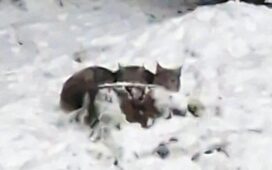Two recent amphibian-focused studies shed light on the ecological importance of red-backed salamanders, while confirming that proactive measures would prevent costly impacts from a wildlife disease spreading across Europe that has not yet reached North America.
Scientists knew that red-backed salamanders were abundant in eastern North America, but a recent study found their densities and biomass across the region were much higher than expected. The study authors estimated an average of 5,300 salamanders in every patch of forest the size of a football field in the Northeast. Even though each individual is a mere 3 inches long, the sheer number of red-backed salamanders means that they also have some of the highest biomass estimated for animals other than insects in the Northeast, similar to or greater than white-tailed deer.
The study, “Range-wide Salamander Densities Reveal a Key Component of Terrestrial Vertebrate Biomass in Eastern North American Forests,” conducted by U.S. Geological Survey and many partner institutions, was the first time that the densities and biomass for this common, but rarely seen, species were calculated across the extent of its range.
The incredible magnitude of red-backed salamander presence in the Northeast captured in this study suggests that red-backed salamanders, and likely amphibians in general, play a more prevalent role in terrestrial temperate ecosystems than previously suspected.
“The very large biomass of red-backed salamanders tells us that they are likely ‘small but mighty’ in terms of their role in the ecological health of northeastern forests,” said Evan Grant, lead author and USGS research wildlife biologist. “If red-backed salamanders disappeared, there would probably be some pretty large ecosystem-level consequences.”
Many salamanders, like the red-backed salamander, are tiny and spend the majority of their time underground, so it’s easy for most people to overlook them. In fact, Grant commonly refers to salamanders and other amphibians as “hidden biodiversity” because, though they are often abundant, they hide well. But that doesn’t mean people should overlook their ecological roles. Salamanders eat things that bigger consumers can’t eat and are themselves prey for other animals, meaning salamanders punch above their weight in an ecosystem’s food web.
“Salamanders serve a vital function in forest ecosystems,” explained David Miller, professor of wildlife ecology at Penn State and co-author of the study. “They are at the top of the food chain on the forest floor, where everything is breaking down into the soil that sustains this entire network of life. In fact, salamanders are so important to this life cycle that we can use them as a barometer for forest health.”
Unfortunately, just as scientists are beginning to understand the true magnitude of salamanders’ ‘hidden biodiversity’ and ecological importance, a new wildlife disease that is particularly hard on salamanders is a looming threat and a serious concern for scientists and wildlife managers.
Batrachochytrium salamandrivorans, or Bsal for short, is a fungal disease closely related to the chytrid fungus that is already devastating amphibian populations around the world. It was first found in the Netherlands in 2013. Sadly, since its introduction, Bsal has decimated the salamander populations in central Europe and continues to spread across Europe.
Bsal hasn’t been detected in the U.S. yet, so scientists and wildlife managers are preparing for its arrival. There is a North American Bsal Task Force whose mission is to limit the invasion and reduce the impact of Bsal in North America. However, natural resource managers ran into a problem when trying to enact proactive management guidance for a disease that isn’t even on U.S. shores yet.
They needed evidence that proactive management would be more effective than waiting to respond until the disease is detected in the wild. So, Grant co-authored another recent paper that tested a series of proactive and reactive management actions to forecast the impact on salamander populations over time.
This study, “Proactive management outperforms reactive actions for wildlife disease control,” used computer modeling to confirm what seems intuitively obvious: namely, initiating management of wild populations before Bsal arrives is, in fact, more successful at achieving the management goal of keeping salamanders from disappearing than waiting until after Bsal is detected or not doing anything at all.
“If we do nothing to manage Bsal, the model forecasted that the disease would be catastrophic to North American salamander species,” said Molly Bletz, assistant professor of disease ecology at Penn State and lead author of the second study. “This study gives strong quantitative support to proactive management actions. Basically, if we want these at-risk salamander species to be around in the future, doing something proactively is our best bet.”
The types of proactive management actions considered included:
- making it harder for amphibians to spread the disease amongst themselves through installing barriers or increasing habitat complexity;
- reducing Bsal fungal spores in aquatic habitats by temporarily raising the water temperatures, increasing the salinity, or increasing the abundance of zooplankton that consume funguses;
- helping amphibians fight off the disease by improving their health through supplemental feeding, etc., increasing the abundance of local, beneficial anti-fungal microbes, or through vaccination.
While this second study did not estimate how proactive management for Bsal may affect other parts of the ecosystem, visitor satisfaction or financial cost, Bletz, Grant and others are already working on estimating these outcomes so that managers have a full accounting of the relative benefit of proactive versus reactive management.
“With a new understanding of how incredibly prevalent salamanders are in an ecosystem, and with the empirical justification for the benefits of proactive management for salamander populations threatened by Bsal, it is more critical than ever to protect the ‘hidden biodiversity’ of amphibians,” said Bletz.














